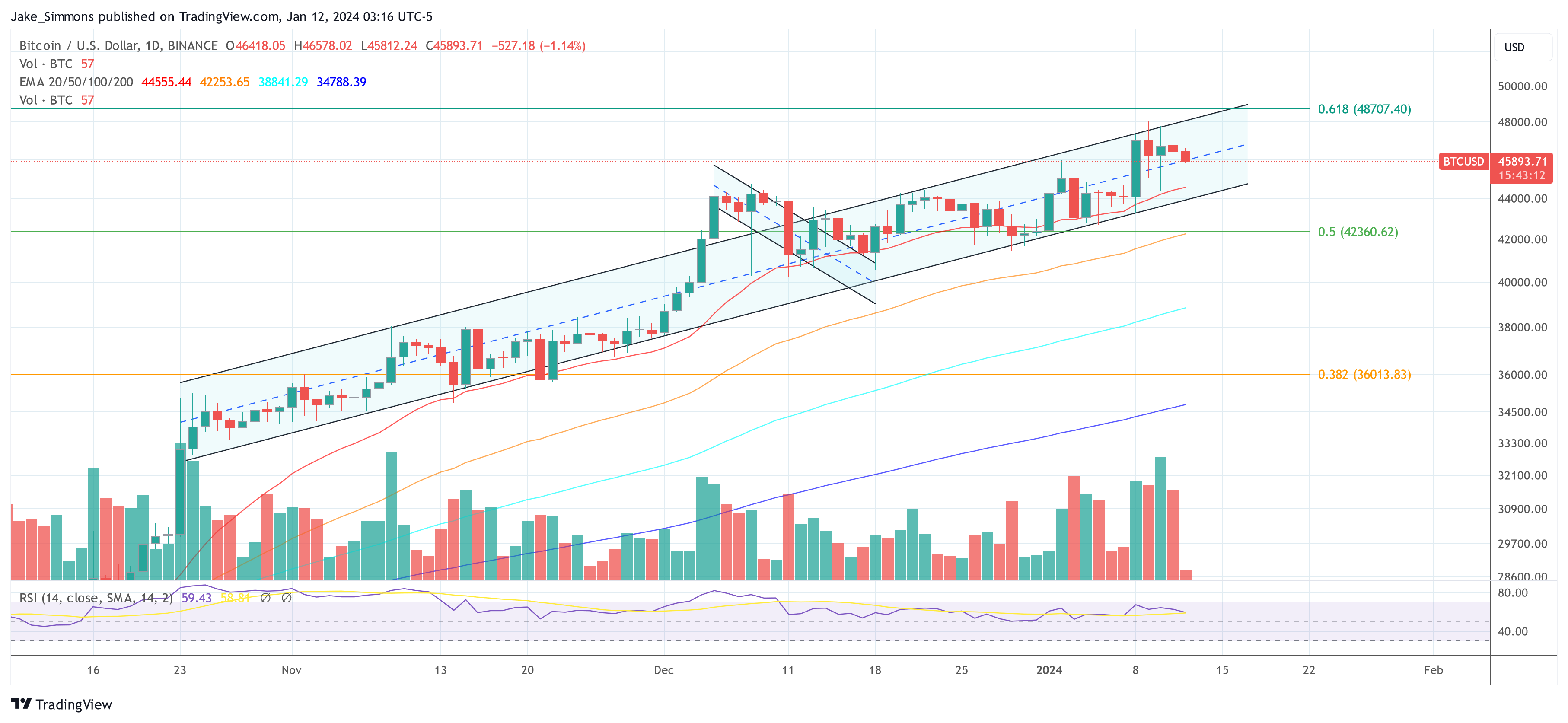Despite a groundbreaking day in the US with the largest Exchange-Traded Fund (ETF) launch for a single asset, the Bitcoin price remained stagnant, hovering around $46,000. This development has raised questions within the community, especially in light of the extraordinary trading volume and participation in the ETF market.
Record-breaking ETF launch
On its first day of trading, Bitcoin ETFs saw unprecedented activity. Total volume reached $4.6 billion, spread across major players such as Grayscale ($2.3 billion), BlackRock ($1 billion), Fidelity ($700 million), ARK 21Shares ($288 million) and Bitwise ($125 million). This event marked more than 700,000 individual transactions.
Nate Geraci, president of the ETF Store and co-founder of the ETF Institute, noticed, “GBTC had the largest ETF launch ever by trading volume with $2.3 billion… iShares Bitcoin ETF (IBIT) had the fifth largest launch with $1 billion. GBTC clearly had built-in liquidity, but it’s still a record. IBIT’s performance is impressive considering it was launched on the same day as 10 other competitors.”
Bloomberg’s ETF expert Eric Balchunas added“All told, there were 700,000 individual trades in and out of the 11 spot ETFs today. For context, that’s double the number of transactions for QQQ (although it’s seeing much larger $ volume because bigger fish are using it). So there was a lot more grassroots action (versus large seed purchases) than I expected, and that’s good.”
Bitcoin price cannot maintain its gains
Despite these impressive numbers, Bitcoin price struggled to cross the $50,000 threshold. Although BTC briefly reached $49,000, it failed to maintain these gains and fell to a low of $45,700. At the time of writing, the price was around $46,000.
Dan Ripoll, CEO of Swan Bitcoin, argued almost everyone expected Bitcoin to either rip or sell off on the ETF news, but neither happened. So what’s behind the muted price response?
Ripoll states that compliance departments at brokerage firms often take “weeks to several months to add new products to their internal ‘approved product list’ so advisors can sell them.” Additionally, the expert explained that several major broker-dealers such as Vanguard, UBS, Citi and Merrill Lynch have restricted or disallowed their retail clients from purchasing spot Bitcoin ETFs.
A major point of contention was Vanguard’s decision to prevent its customers from buying into the new BTC Spot ETFs, arguing that these products “do not fit with Vanguard’s investment philosophy.” This move by the world’s second largest asset manager after BlackRock further complicates the landscape for Bitcoin ETF adoption.
“There may also be other brokers who have blocked these sales for ideological reasons. They don’t believe in Bitcoin. I didn’t expect this at all. With this strategy they will quickly lose customers,” Ripoll said.
Matt Dines, Chief Investment Officer at Build Asset Management LLC, added another very important fact that is probably not widely known:
The dollars behind today’s spot ETF volume haven’t even reached fund managers’ desks yet. Most are creating orders behind today’s flows and will be cash settled tomorrow morning at T+1…that is, the capital behind today’s wave hasn’t even started increasing offers in the UTXO market.
Rotational games and GBTC sales
Additionally, there are reports of investors leaving Bitcoin ETF proxies, such as BITO and mining stocks, to reallocate capital to better proxies, such as the new spot ETFs. This shift may have suppressed ETF inflows somewhat and may take months to fully materialize.
It is also interesting to note that Grayscale accounted for half of yesterday’s trading volume, much of which could have been sell orders. In the run-up to the spot ETF’s approval, GBTC was a popular bet among speculators who had at times taken advantage of the 40%-plus discount in the hope that it would close with the ETF’s launch. This is exactly what happened: GBTC was only trading around -1% yesterday.
So most of the GBTC trading was probably selling. This is supported by the fact that it probably doesn’t make sense for investors to hold the GBTC with its huge 1.5% annual fee, while other spot Bitcoin ETF issuers offer 0.25%.
Fred Krueger, a crypto expert, stated: “GBTC volume should be 90% turnover. Part of that went to IBIT.” BitMEX research commented, “GBTC volume could be mainly sales and outflows. It has been trading at a discount for most of the trading day, so a buy is not likely to occur.”
In summary, the lack of a significant Bitcoin price increase despite the record ETF day can be attributed to a combination of factors, including GBTC sales, compliance delays, broker restrictions, fund rotations, and ideological stances of major financial institutions.
At the time of writing, BTC was trading at $45,893.

Featured image created with DALL·E, chart from TradingView.com
Disclaimer: The article is for educational purposes only. It does not represent NewsBTC’s views on buying, selling or holding investments and of course investing involves risks. You are advised to conduct your own research before making any investment decisions. Use the information on this website entirely at your own risk.

